“Thanks Neha Jee for giving us the opportunity to inspect your Home. These Testimonials keep motivating us to strive for the better, and to do the Best. Our Happy Customer, Ms. Neha Singh – Listen to what she has to say about us.
A Buyer’s Choice Home Inspections, USA Expands to India in partnership with MACJ, India
Professional Home Inspection for the First Time in India
Bill Redfern, founder and CEO of internationally recognized A Buyer’s Choice Home Inspections (ABCHI), announced today a signed agreement through partnership with MACJ, India to bring the company to India with plans to open 100 units in the next five years. MACJ, India has been co-promoted by Mahendra Sureka, Arvind Kumar Bhotica along with a couple of investors.
Mr. Mahendra Sureka (Founder-CEO, MACJ India) says “Professional Home Inspections Services is the need of the hour. The demand is unlimited and we hope to provide quality & assured services with complete transparency that will fulfill the need of all stake holders, i.e., developers, home buyers, real estate agents, bankers, insurers and the government. It will fill the void of the real estate industry as well as open new avenues of skilling and providing employment opportunities in India”.
Mr. Sushil Mohta (Promoter, Merlin Group / President, CREDAI, Bengal) said that this initiative will be a boost to the industry by giving quality assurance to the end user and enhancing developers’ goodwill and brand.
Mr. Jonathan Ward (US Consulate General’s Principal Commercial Officer, Eastern / North-Eastern India) was glad that a leading American company, ABCHI has come to India to introduces its US standards and also invest in the JV.

Seal all Gaps in your Homes
Most of us are so busy that we cannot even look after our home/property, so that it remains maintained in a good condition for a long time. During monsoon, we sometimes observe the presence of moisture or patches around the window or even water seepage. This usually happens due to gaps around window frame caused by sealant deterioration1 which is often over looked by a homeowner or resident. Besides, many people may not be knowing about these unfilled gaps, the reason behind it and negative effects. Hence it gets unnoticed and the result is a costlier repair & unwanted hassles.
Let us understand first – What is a Sealant?
A Sealant is a liquid form of material that usually looks, feels, and acts like a gel. Sealant is a substance used to block the passage of fluids through the surface or joints or openings in a material. For better understanding, it is a material that is used to seal the joints between materials such as concrete, aluminum etc. In general, joints are provided in the structures to prevent the damage produced by stresses.
A Sealant can keep its elasticity & stability in both temperatures – high & low. Additionally, it is resistant to other chemicals, moisture and weathering.
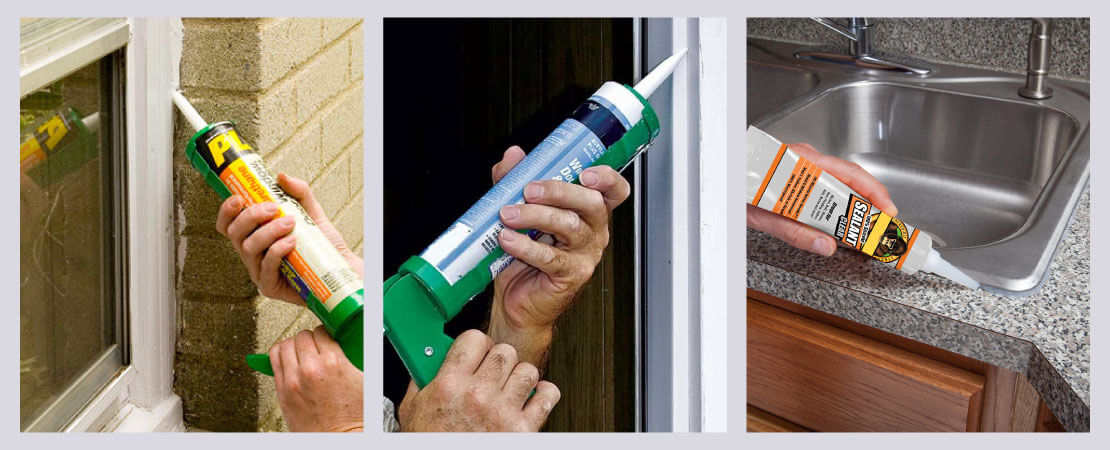
Application of Sealant in Home
Sealants are used between materials having different thermal movement. In addition, these are also used in the glazing joints and sealing of porous surfaces to non-porous surfaces. The areas where sealants are used in the homes are:
- Gap between wall and window frame at both sides (i.e. gap around the window frame)
- Gap around the door frame
- Gap around sink installation in your kitchen
- Gap around AC gas pipe2 Sleeve
- Joint between furniture pedestal and floor
Apart from these, there are other gaps in homes like tile joints in the bathroom, counter stone joints in the kitchen etc. which need to be filled. But as the material is the same, tile or stone grout3 can be used in the joints.
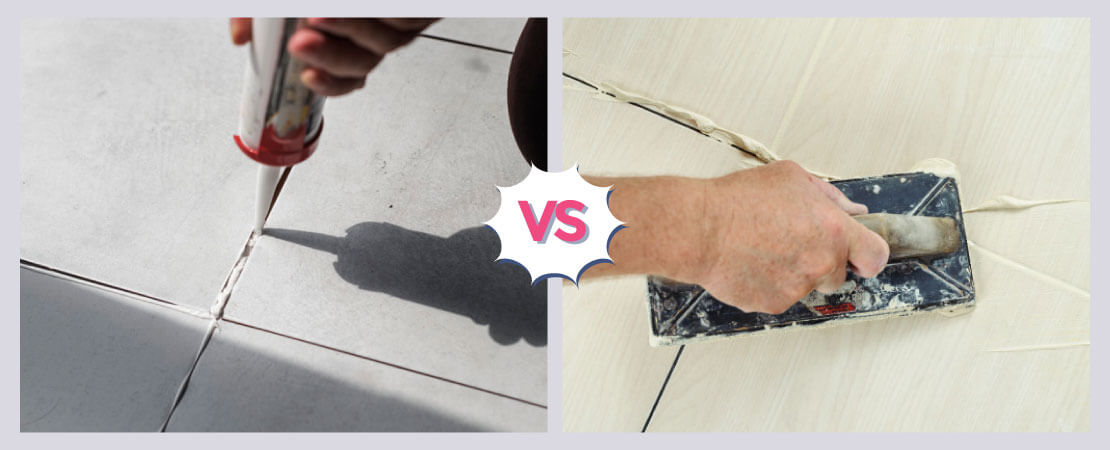
Difference from other fillers (grout)
Let us just understand the difference between sealant and grout:
| Sl. No. | Sealant | Grout |
| 1 | A sealant typically refers to a high performance compound having more expensive ingredients, little shrinkage, excellent weathering and UV resistance. | A grout is any intermediate performance compound. Typically being lower quality. |
| 2 | It is usually flexible material. | It is a rigid material. |
| 3 | It provides long service life cycles from 10 – 20 years. | It has a service life of around 5 years. |
| 4 | It is costlier than grout. | It is cost-effective. |
Beside the above differentiation, there may be different materials (like tile and counter stone joint) having different movements due to thermal changes. In that case use a sealant, as it works well where differential movement can cause your grout to crack. It is very important to choose junction filler wisely to increase its longevity.

Desirable Properties
Sealants used in filling gaps, joints and cracks must be shrink free. Sealants should also have excellent bonding and adhesion properties so that these do not come off when subjected to the sun rain, heat or cold temperature.
After application and on drying, these should form a permanent elastic rubber-like seal to serve their purpose. These should therefore be UV resistant and should offer a long-term durability.
Apart from this, we want to tell you briefly about commonly used sealants among different types4. Silicone sealants are the most commonly used sealants. These are transparent and take 10 to 20 minutes to form the sealing skin over the joint or gap. There are two types of silicone sealant preferred to be used for homes.
- General purpose silicone sealant – It is a type of sealant which is used in interior areas.
- Exterior grade silicone sealant – It is the type of sealant which is used in exterior areas. It is more chemical resistant and can withstand different weather conditions.

Benefits of using sealant at Home
Using a good quality sealant can be very beneficial in protecting your home.Proper sealing of windows and doors is something that should not be overlooked. Now let us walk you through benefits of using sealant (related to the common use of sealing around door and window frames) which will be helpful in understanding its importance:
- Saves from damage to the home/property: Due to unsealed gaps around windows (reason can be sealant deterioration or sealant not being used) and doors, the moisture / water may seep into your home. Most common damages inside homes occur due to water seepage through the gaps between window frame & external wall. This gap will be a source for moisture to flow inside the home. If the gap is not filled properly, it will lead to moisture intrusion, paint deterioration & damage to walls and other associated areas. This point is applicable to other areas of the home as well where sealant is used. Hence using sealant and checking its condition can avoid the entry of moisture in your home.
- Keeps Insects away:Unsealed windows and doors make it easy for little creatures like mosquitoes, ants, spiders etc. to invade a home.
- Health Factor: Besides the fact that it will keep insects from moving in, it can also be beneficial to keep pollen and allergens outside. This can be extremely helpful for those who suffer from seasonal allergies. Secondly, as we have already mentioned that moisture intrusion can occur in the home due to unsealed gaps. This will not only damage the property but also cause health hazards due to moisture.
- Improves Energy Efficiency: If your doors and windows are properly sealed, then the temperature of the room can be maintained or regulated during both seasons (summer & winter). Improper sealing ultimately makes it more difficult for a cooling system like Air conditioner (AC) to regulate temperature. When AC is constantly working harder to regulate the required temperature within the home, chances are that energy costs will increase. Not only it will be more expensive, but it will also put more stress on the system/appliance than necessary.
- Obstructs outside noise: Sealing windows and doors properly can also prevent street noise from entering your home and residents can continue to enjoy the peace and serenity inside their home.
- Well maintained Window: A buildup of moisture being untreated for a period of time can cause your window (or door) to begin to warp and lose shape. Checking the condition of sealant is one of the tip for window maintenance.
Conclusion
Sealant plays a significant role in your home. When unwanted gaps are properly sealed, deterioration can be over and you can enjoy your life’s big investment for a long time. Our objective of writing this content was to tell you about the usage and importance of sealants for your home. Also, we wanted to create awareness that sometimes a small defect in your opinion like a gap around the window frame or sink, if left unnoticed can create a much bigger problem in the future.
Reference links used:
1. http://restoremasonry.com/capability/building-sealant/
2. https://home.howstuffworks.com/home-improvement/household-safety/10-ways-to-bug-proof-your-home.htm#pt5
3. https://www.tileoutlets.com/blog/why-you-need-grout-when-you-install-tile-and-stone/
4. https://www.tribuneindia.com/news/archive/features/choose-the-right-sealant-172448
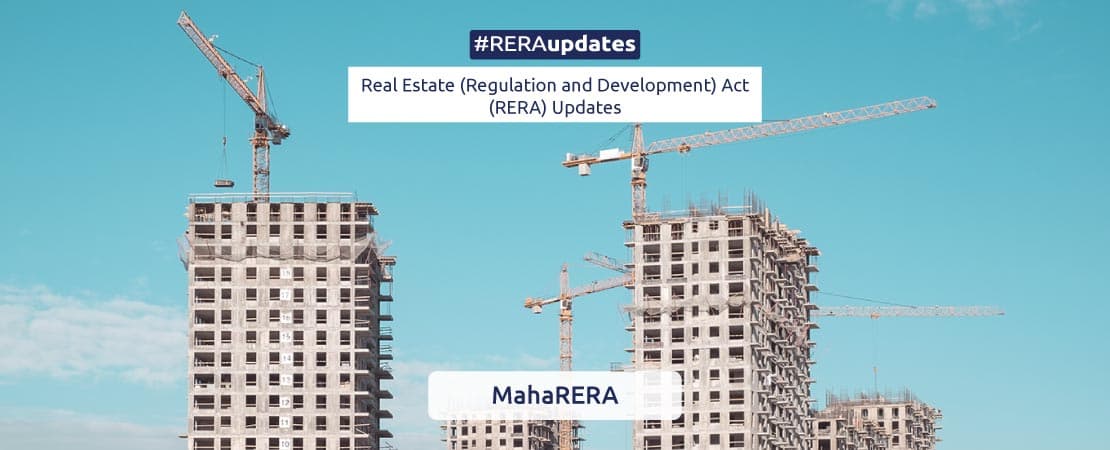
Should you keep paying EMIs after the builder misses possession date?
Mumbai
In a recent case involving a housing complex, Rivali Park Project in Borivali—now called Wintergreen—the builder contended that buyers making payments after the possession date has passed amounts to them agreeing to the delay. But the Maharashtra Real Estate Regulatory Authority (MahaRera) rejected the developer’s claim that the homebuyers had consented to the delay because they kept paying the instalments despite the chance in possession date.
“As per Rera guidelines, in case of a delay by the developer in completion of the project, buyers may opt for either cancelling the deal and claiming refund with interest, or to continue the agreement and seek compensation for the delay period,” said Mukesh Jain and Associates, a Mumbai-based law firm.
Even though MahaRera ruled against the builder in this case between CCI Projects Ltd. and homebuyers, saying buyers were eligible to receive interest payment for the delay period, this might not always be the case.
So, does it make sense to keep making payments after the promised possession date passes?
According to Anuj Puri, chairman, Anarock Property Consultants, you may not have a choice.
“Frustrated with the prolonged project delays, many buyers stop payments to developers. However, under the agreement to sale, sellers or developers are well within their legal right to cancel the booking if buyers fail to honour their part of the payment deal. Since each case may be different, a legal person must always advise on such matters,” he said.
Puri added that although MahaRera ruled in favour of the buyers, the exact variables may differ from case to case and not all such cases are equal in the eyes of the law. “Despite Rera being in place across the country, it is still largely work-in-progress. It is very much a case-to-case scenario. Moreover, respective states’ and union territories’ Reras have their own rules and regulations. Therefore, buyers should first seek local legal advice before taking any action,” he said.
According to Anuranjan Mohnot, MD and CEO, Lumos Alternate Investment Advisors Pvt. Ltd, Rera needs to be simplified to protect interest of homebuyers as well as developers.
“To avoid situations like this, Rera should introduce a milestone-based project review instead of just having one parameter of delays with respect to the possession date. This will help buyers to sense serious deviations at an early stage and they can approach Rera for taking proactive steps to avoid major delays,” he said.
Even in states with a fully functional Rera in place, moving the authority in favour of homebuyers might turn out to be a challenge. It can be very frustrating to have inordinate delays in getting possession of your house, but discontinuing payments can cause further complications. Consider the circumstances and seek legal advice to protect your interests as a homebuyer.
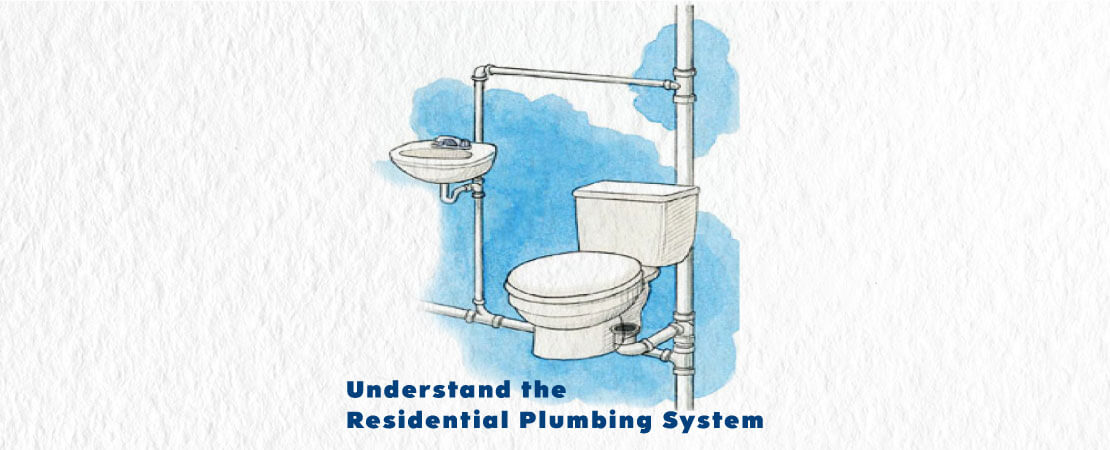
Understand the Residential Plumbing System
Your home’s plumbing system is important to keep your standard of living comfortable. If it is not working properly, you would not be able to take a shower, wash your hands, use the toilet, wash utensils, or run the washing machine. Plumbing systems are responsible for quite a bit. However, most people do not know what their plumbing system is. They just turn the handle or press a button and expect the water to come out at the pressure they want.
As a homeowner, it is important to have a basic understanding of how your plumbing system works so that you can take better care of it and prevent a costly breakdown. Because plumbing is complicated and one of the costliest systems to repair or install in a home, it is important to understand how the system works.
The residential plumbing system is a complex network comprising of hot & cold water supply pipes, fixtures, drain pipes, traps, valves,vent pipes, water storage tanks, etc.
A plumbing system serves two purposes: to supply water for human use, and to get rid of human wastes. It consists of a store of water that is distributed to various outlets.
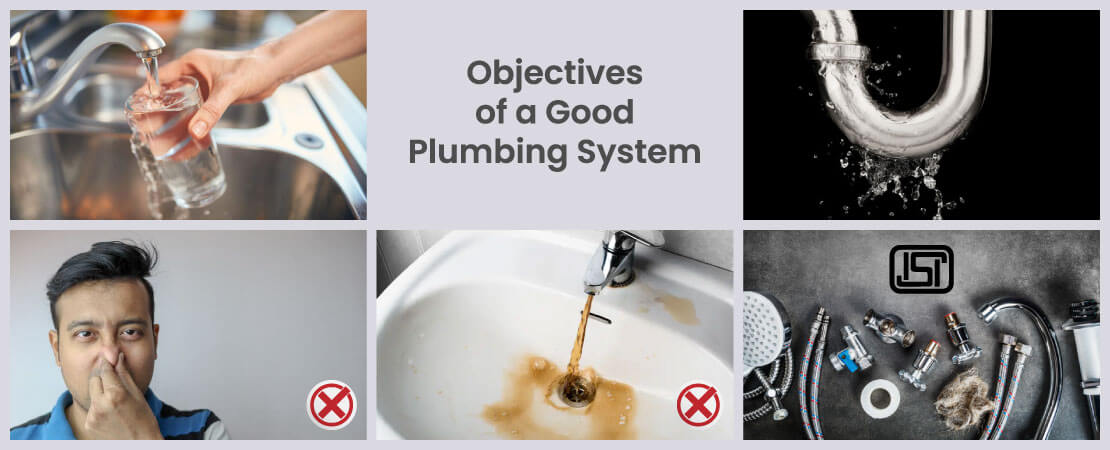
1. Objectives of a Good Plumbing System
A good residential plumbing system makes a home a more comfortable and liveable place for the family. Ideally, it should:
- Consistently supply safe drinking water
- Efficiently collect and dispose of wastewater
- Have no leaks that can waste water and create further problems
- Prevent foul odours from escaping the system
- Prevent clean water and wastewater from mixing together
- Be connected to fixtures that meet quality standards

2. Essential Parts of Residential Plumbing System
- Water Supply System (flow of water into a house)
- Fixtures and Appliances (where water is used for carrying out various activities)
- Drainage System (collection and disposal of used (waste) water)
a. Water Supply System
- We are all aware that Potable water is supplied by the municipality or through private underground bore well.
- This water enters a house through the main supply line. Water supply in a house is either of direct water supply system or an indirect water supply system.Let us understand it briefly:
- Indirect water supply system: Water from mains is conveyed to storagewater tanks. The underground storage tank is connected to an overhead tank via a pump and a supply line; the water flows from there to any tap or outlet by gravity. This system is mainly used when water pressure in mains is not sufficient enough to deliver water at all faucets with adequate pressure. In India, usually we follow this system.
- Direct water supply system: All water outlets of a house receive water directly from the underground tank with the use of a pump that supplies the water directly from the underground tank to all outlets. Such a pump should be able to continuously supply the line with pressure, so that whenever one opens a tap, water flows out.
To understand in detail about both direct and indirect water supply system, click here1.
b. Fixtures and Appliances
Fixtures, which are typically equipped with faucets, are needed so that the water supply can be used properly. Examples of these are showers, bathtubs, toilets, and sinks. Electric appliances such as dishwashers, washing machines, and geysers use water and must be connected to the waterline. The water in the pipes need to exert a bit of pressure so that it can be used in fixtures and appliances.
c. Drainage or Waste Water Disposal:
The wastewater system collects and disposes of wastewater through the use of gravity. The used water goes down drain traps that prevent foul gases from being released inside the home. The wastewater exits the home through the wastewater mainline, then it is collected in the septic tank or the municipal sewer line.

3. Areas and basic components of plumbing in the Building
a. Bathroom: Basic plumbing components in a bathroom are:
- Main valve – to control the water flow
- Basin – only cold or cold + hot inlet point & one outlet point
- Water Closet – Health faucet point, cistern flush inlet point, outlet soil pipe
- Shower – one head shower, one faucet, shower diverter, one floor outlet pipe
- Geyser – inlet cold line & outlet line
- Additional points like bathtub, washing machine, etc
b. Kitchen: Basic plumbing components in a kitchen:
- Main valve – to control the water flow
- Sink – only cold or cold + hot inlet point & one outlet point
- Additional points like dishwasher, washing area tap point, etc
c. Roof/ Open terrace/ Balcony:
Basic plumbing components in a balcony/open terrace:
- One or more rainwater outlet pipe
Basic plumbing components in a Roof:
- One or more rainwater outlet pipe
- Water tank & pipelines
4. Types of Plumbing Pipe lines in a Building
There are mainly 3 types of water running in a building:
a. Supply Water
- Generally, single source of water (eg bore well water) is used for every use. i.e. drinking, cleaning, bathing and toilet flushing.
- In a large complex with STP plant, water from plant is used for toilet flush only.
- In some areas, water from the government body is used for drinking purposes Only. Bore well water can be used for other purposes.
b. Waste Water: Two different pipes are used for waste water:
- Floor outlet pipe i.e. bathroom & kitchen waste water from bath & cleaning
- Soil pipe – used for WC outlet pipe
c. Rainwater: Rainwater pipe is used for roof & open terrace rainwater outlet.
Apart from this, a vent pipe (usually connected to the soil and drain pipe) is provided for the purpose of the ventilation of the system. A vent pipe is open at top and bottom, to facilitate the exit of foul gases.
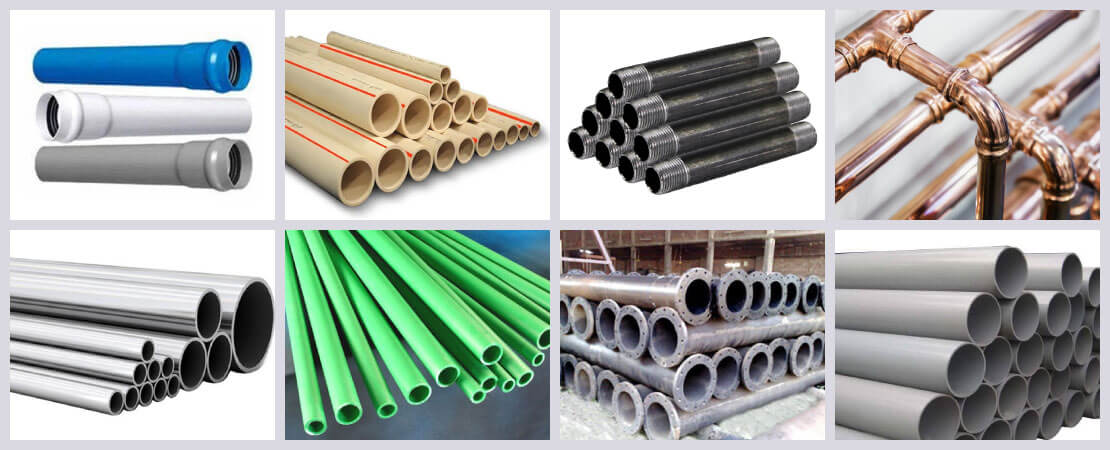
5. Types of Plumbing Pipes
a. Fresh water pipes
- Unplasticized polyvinyl chloride(UPVC)
- Chlorinated polyvinyl chloride(CPVC)
- GI pipe (Galvanized iron pipe)
- Copper pipe
- Stainless steel Pipes
- PEX or Cross-linked Polyethylene Piping
- PPR pipe
b. Waste/soil/rainwater pipes
- Cast iron Pipes
- PVC pipes
There are various other types of plumbing pipes for residential buildings or others. Each pipe has its different characteristics and application.
Conclusion
This is your home’s plumbing system in a nutshell. It is much more complex than this, but with these basics in mind, you will hopefully have a better understanding of how your plumbing works and where a potential problem could be. If you would like more information about plumbing, have any questions regarding your plumbing system, want to have plumbing maintenance or you are experiencing a problem and need professional help, then click here.
Reference links used:
1. https://gharpedia.com/blog/direct-vs-indirect-water-supply/
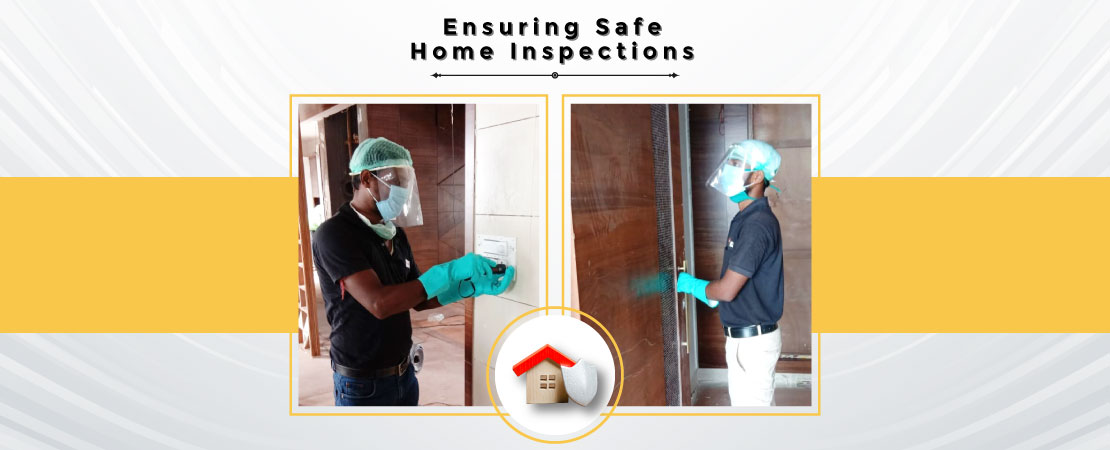
Ensuring Safe Home inspections
The Coronavirus pandemicis still going on. Millions of people globally have been caught in the grip of this virus and many have lost their lives. Now everyone is scared about themselves and their family’s safety. No one wants outsiders to enter in their homes.
Pandemics, call for preparedness and not panic.
Considering the safety of our clients and team, we follow certain protocols which will remove doubt regarding well being & hygiene of your family. Considering the worry of our customers to get their home inspected in this pandemic, here is how we work keeping in mind the safety & hygiene for our customers as our priority:

1. Safe travel to the site
We give importance to commuting to the inspection site. In this pandemic, we strictly restrict the use of mass public transport by our team.They use bike or company driven car.
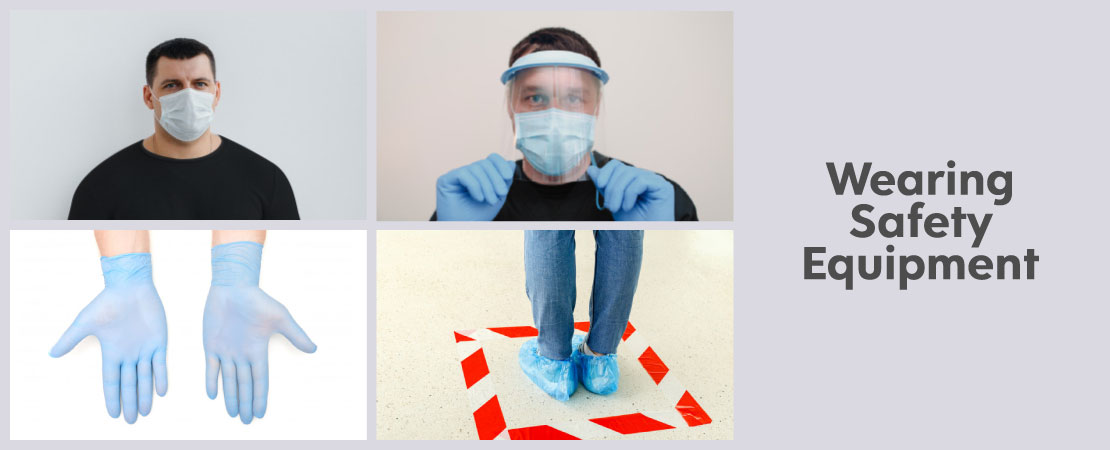
2. Wearing Safety equipment
Our inspection team wears need based safety equipment – Face mask, face shield, hand gloves, shoe covers, etc. We wear disposable, fresh & sanitized set of safety equipment at the site before beginning the inspection.
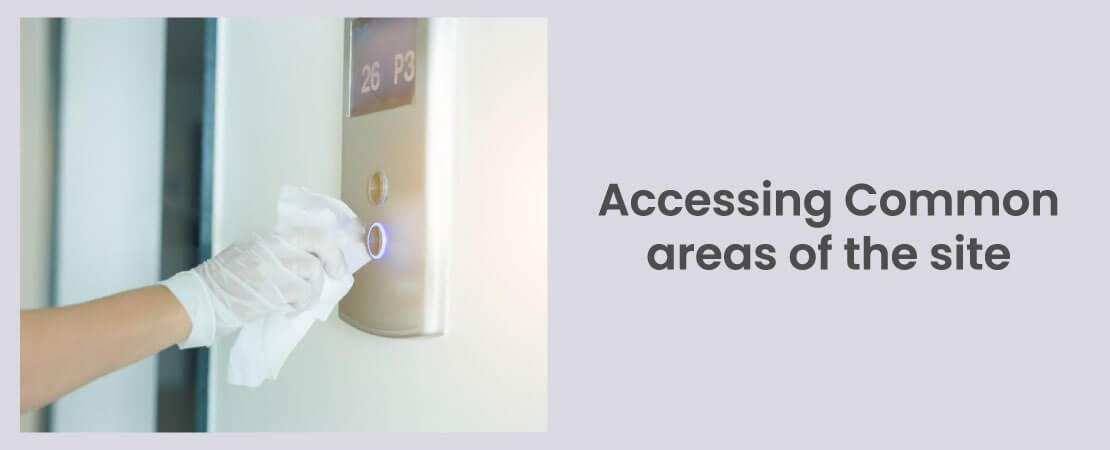
3. Accessing Common areas of the site
Our team follows safety measures while accessing common areas of a building (lift, staircase etc) by avoiding support of a handrail during usage of stairs. And safely operating lift by one person of the team that too with help of tissue paper which is disposed after usage.
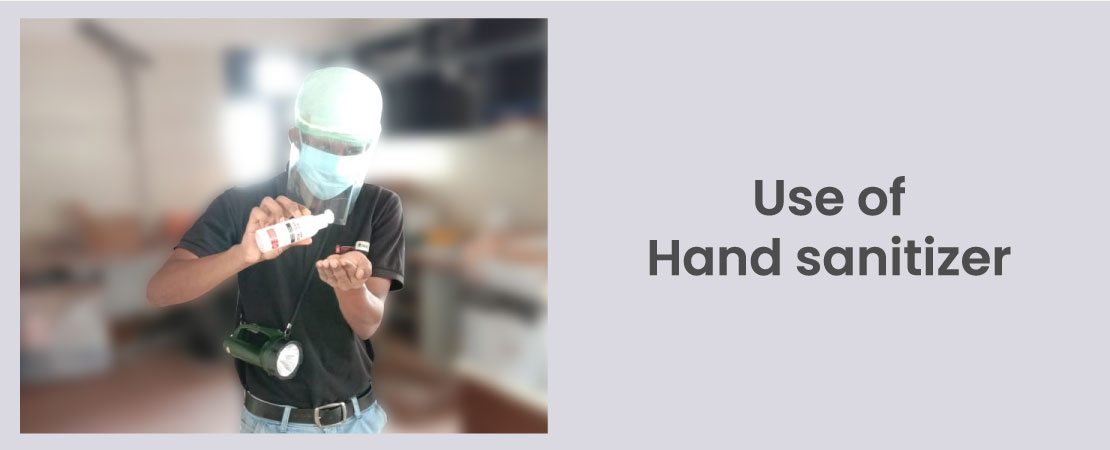
4. Use of Hand sanitizer
Hand sanitizers are generously used by our team during the home inspection process, also before wearing and removing safety equipment. They will always follow hand hygiene to avoid the spread of virus and germs.
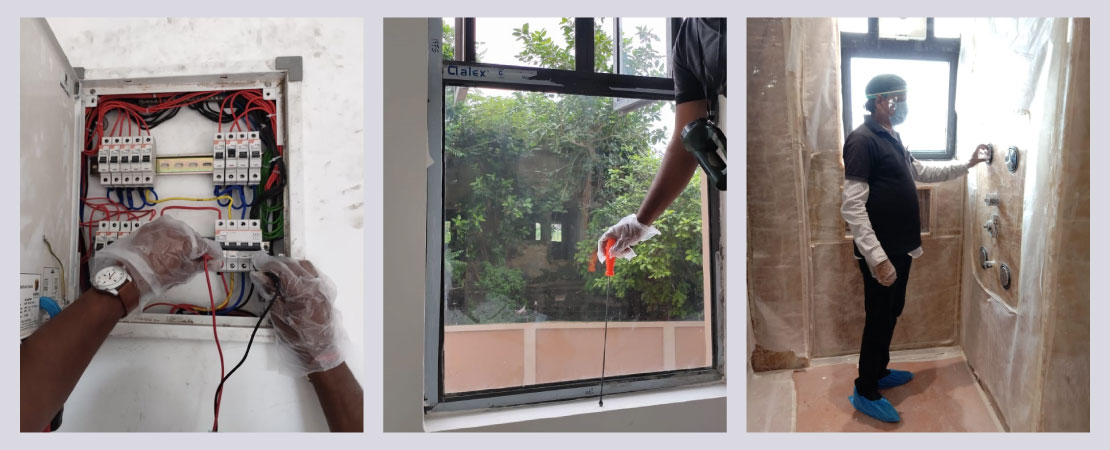
5. Using inspection tools safely
All home inspection tools used only with gloves donned. Besides, they are being cleaned regularly.
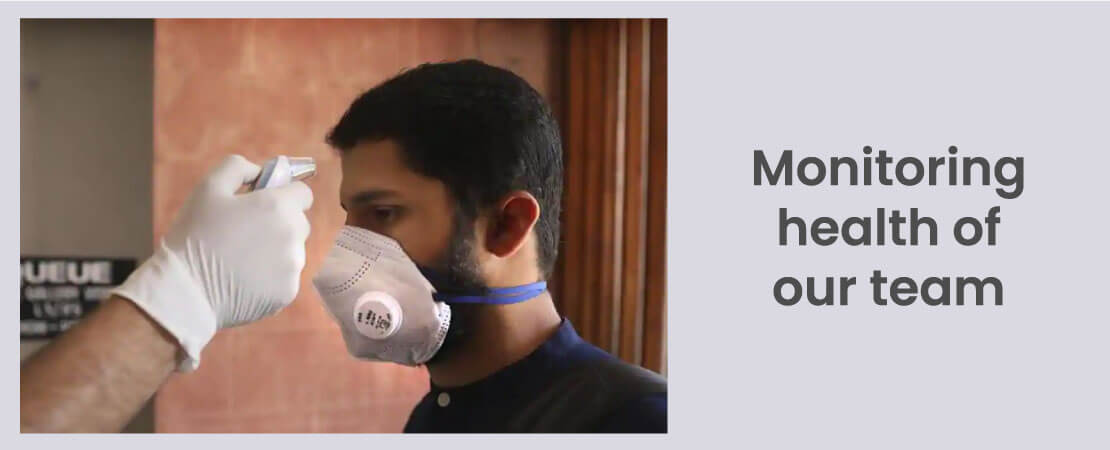
6. Monitoring health of our team
None of our inspectors or other team will work when they have a fever, cough or shortness of breath. We ensure monitoring of their temperature and health for the safety and well being of our customers and team.
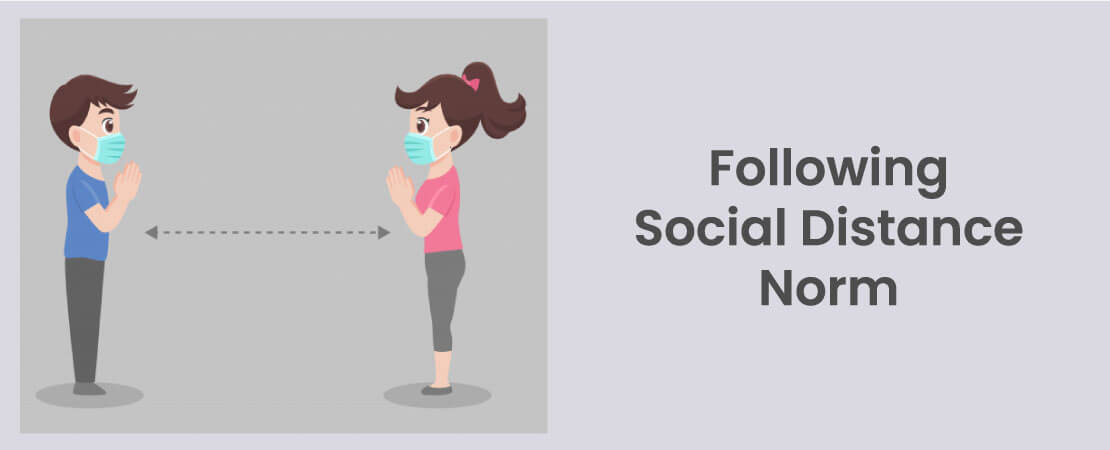
7. Following Social Distance Norm
Our team follows social distancing norms – interacting with a customer at a safe distance. If the home’s occupants are in the home, the occupants are advised to stay in a centralized / separate location during the inspection and not follow the inspector around. Under no circumstance should the occupants be within 6 feet of the inspector. We encourage work from home and direct to site culture for increased safety.

8. Safer report exchange and payment option
Being a company that uses technology, the inspection report is exchanged digitally (via email) and our payment process is online mode also depending on the requirement of our customer. This option is for the customers who are sceptical about the point of contact during current time as physical reports or currency notes can spread infection.
Apart from the above, all inspectors are available by phone or video call after the inspection for follow up discussions / queries on our inspection report. Our team maintains cleanliness and hygiene during the entire inspection process. By working together, we can continue providing outstanding home inspections while better protecting our clients, team, home’s occupants and others.
MACJ – A Buyer’s Choice Home Inspections, a pioneering Professional Home Inspection Services in India is trying to set high standards for the Indian home / property inspection industry – on how to respond to the current situation. We would also like to tell you that the mentioned safety protocols are being followed for all types of our inspection services at this current time. The health and safety of our customers and team are our first priority. Besides, we always try to ensure proper health and safety of your family and home/property by detecting issues and providing solution for specific issues. A Home inspection is significant and essential to ensure a healthy & safe home.
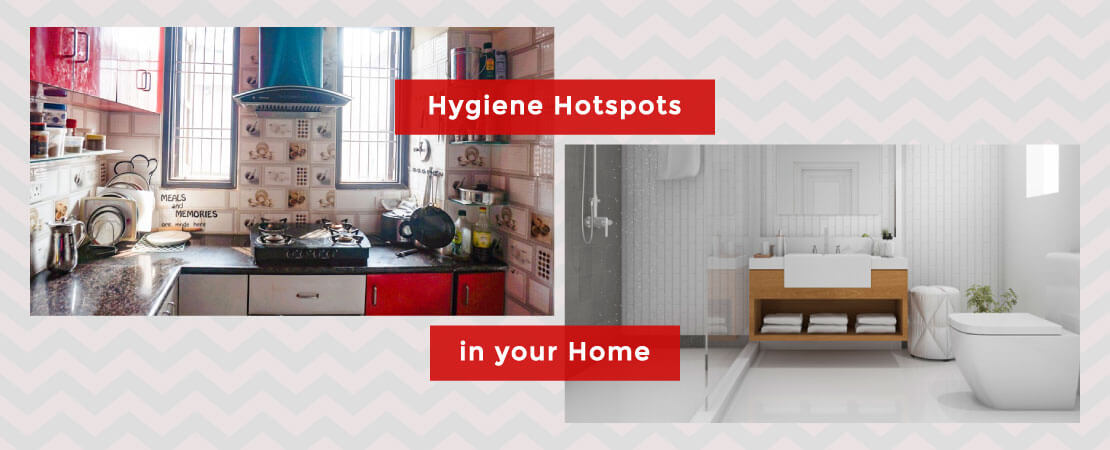
Know the Hygiene Hotspots in your Home
We may do a good job of keeping our Homes cleaned and sanitized, yet there are spots that often get overlooked and neglected. There are many corners in your house that need more than just simple cleaning. Make sure you reach all those hygiene hotspots around your home and sanitize them thoroughly. You may not know but germs must be lurking around to make life miserable for you and your family. Do not take chances because hygiene is crucial. Read on to know which are the hygiene hotspots in your home and how best you can sanitize those spots.
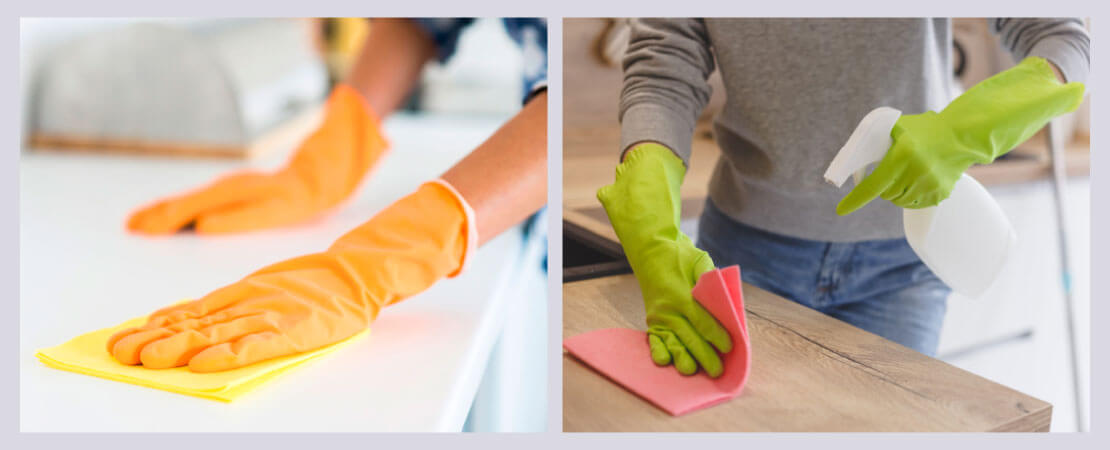
What is washing and sanitizing?
Washing is a mere cleaning of the surface. While you wash your countertop in the kitchen or the floor in the bathroom, you just get rid of food particles, soil, dust, and other such unwanted elements. Some amounts of bacteria also get washed away in the process but not all. You can wash a surface using simple soapy water, vinegar mixed in water, or any of the branded cleaning products available in the market. But sanitization is not just a removal of dirt, grease, and food debris from a surface. There are bacteria and other pathogens on the surface. You cannot see them with the naked eye. Sanitizing kills those germs and makes the surface completely contamination-free. For hygiene hotspots in a home, washing alone is not enough; following up with proper sanitization at regular intervals is also important.
Which are the hygiene hotspots at your home?
To keep home healthy for the family, it is important to maintain good hygiene. This means is to do all you can to prevent your home environment from becoming a breeding ground for disease-causing germs.So, have a look at the following spots in your home.
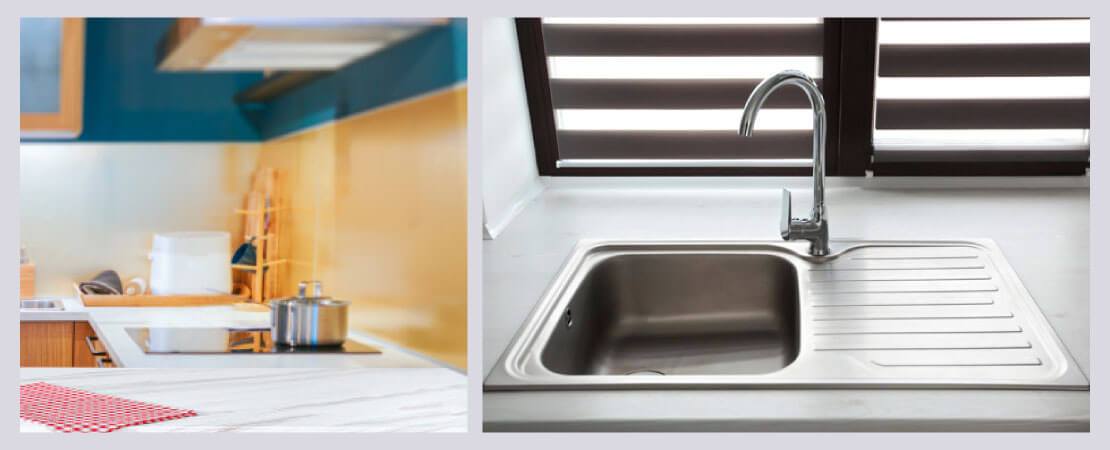
1. Kitchen countertop and sink
Food, dust, bacteria, and liquid spills- you name it and you have it on your kitchen countertop. Raw meat, fish, green vegetables everything is on it. You wash all of them in your sink too. The food particles are left to sit in there and give rise to health risks. Thus, a range of microbes can be present here. The same stands true for the cutting board too. A mix of fruits &vegetables, meat, fish in raw form increases the chances of contamination.
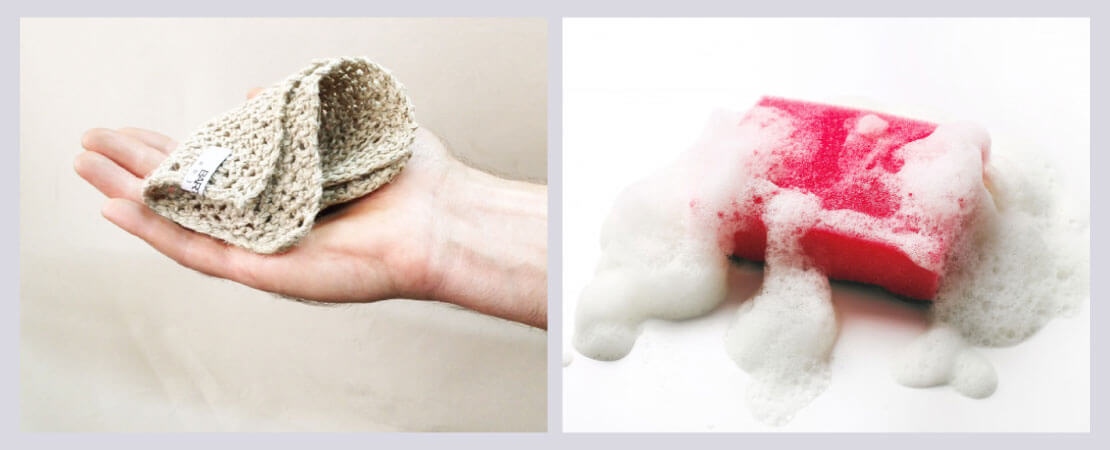
2. Washcloth and sponges
They do not occupy a large part of your mind when you set to sanitize your home. But trust us, a lot of dirt is left behind in them even after cleaning. These remain damp and wet. Now, bacteria grows well in a moist environment. Your washcloth and sponges are a warm abode of them. Using the same sponge for months? You are only spreading the bacteria all over the home.
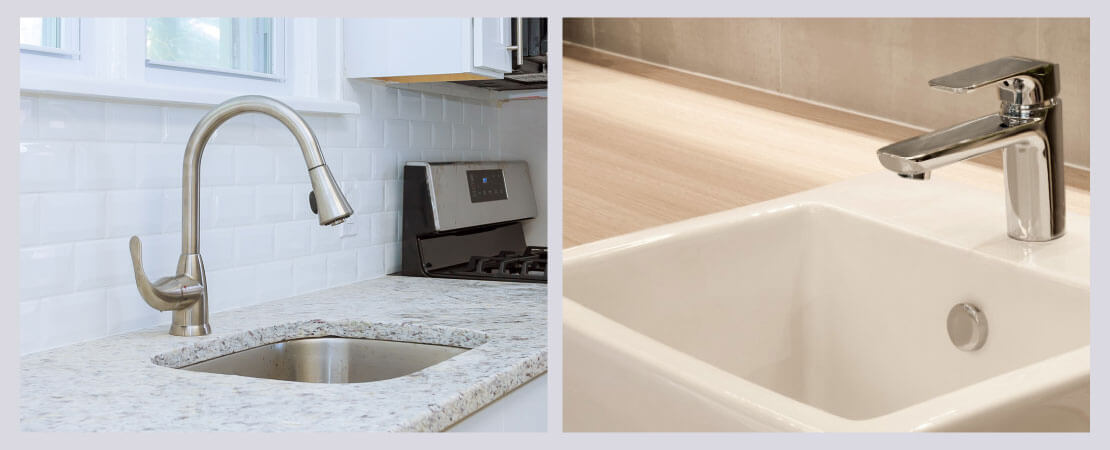
3. Kitchen and bathroom faucets
The taps and other faucets in both the kitchen and the bathroom get dirty and contaminated easily. Very often you touch these objects with dirty hands. When someone else puts their hands on them they automatically get infected.
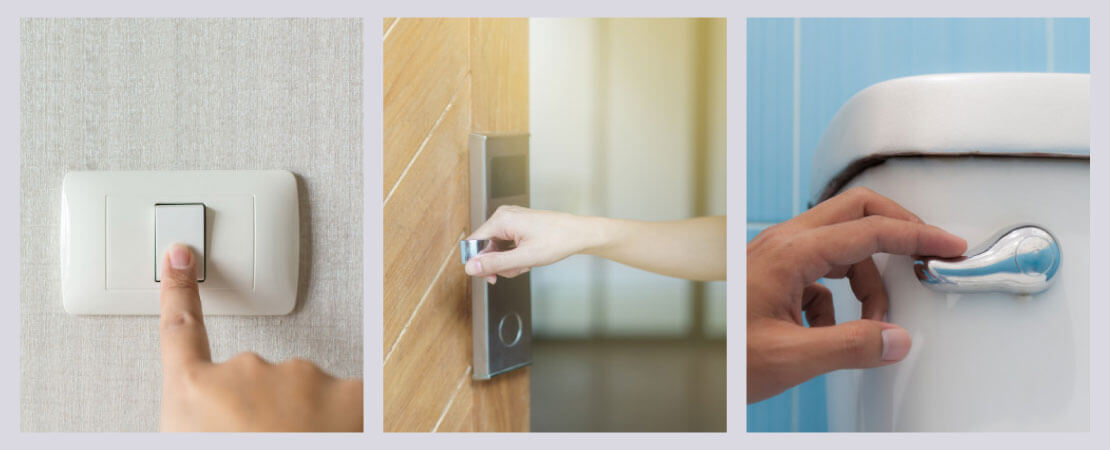
4. Knobs, handles, and switches
Handles of doors and kitchen cabinets, doorknobs, switches, and toilet flush buttons are smaller surfaces. But they pack a lot of punch in terms of germs. Many users are handling them daily. Contamination risks are high too.

5. TV remote, Telephone handset, Kids’ toys
Being handled by multiple users, even during snacking, the TV remote is home to multiple pathogenic bacteria causing pneumonia, diarrhoea, skin infections, etc.
Telephone handset & mobile phones are also one of the germspot. As mobile phone is a device that is with you almost all the time, and everywhere carries many germs on its surface at any given point of time.
Kids’ toys, when playing outside, become dirty. Kids may sneeze on the toys and put it in the mouth the next moment. Contamination all over!
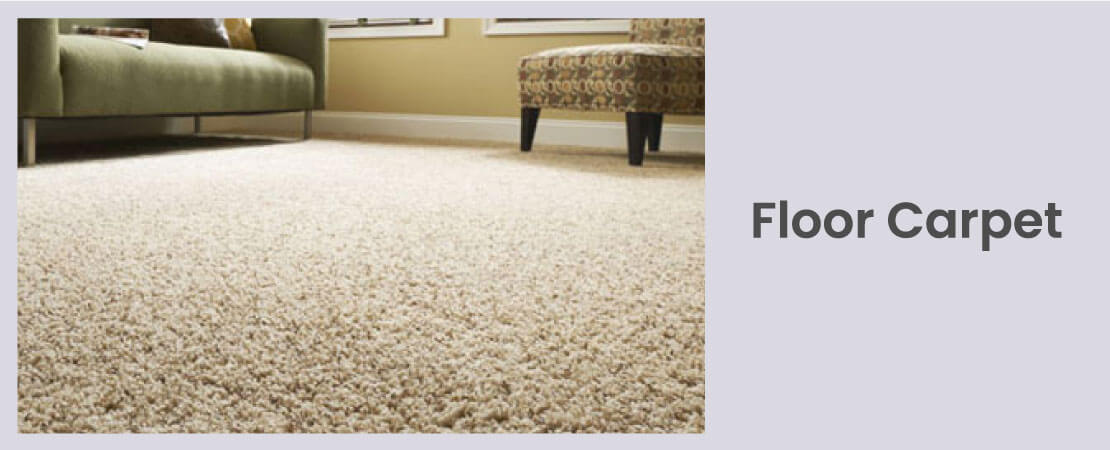
6. Floor carpet
A Carpet usually carry a lot of dust which is not so good especially for people with dust allergies. These can collect dust, germs and indoor allergens such as house dust mite debris, pet hair etc.
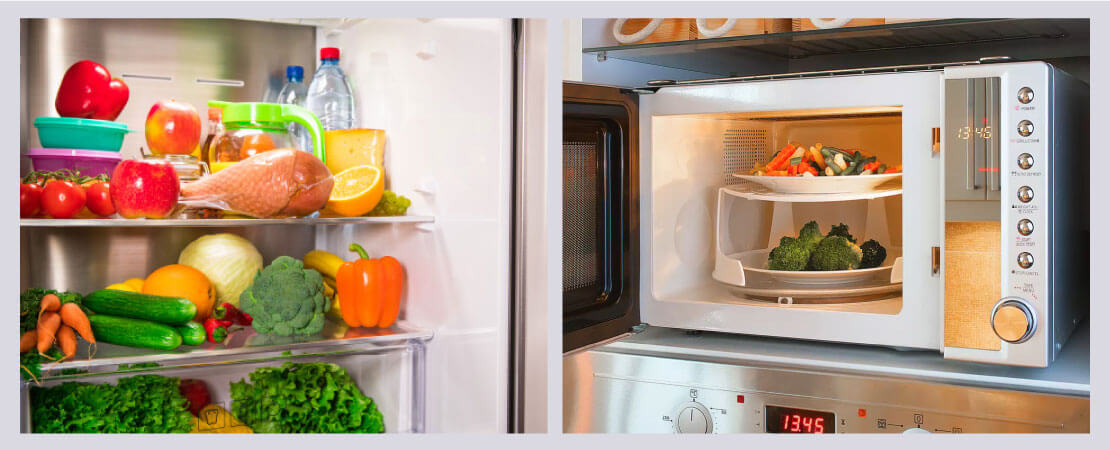
7. Inside the refrigerator and micro oven
Proper cleaning of the refrigerator is vitally important, though is often overlooked and viewed as “too hard”. Did you know that dirty fridges can act as a breeding ground for harmful bacteria such as salmonella, listeria and E. coli?
Microwave ovens also attract germs on a regular basis. Foods are taken in and out of these appliances randomly. This makes them breeding ground for bacteria and other germs.
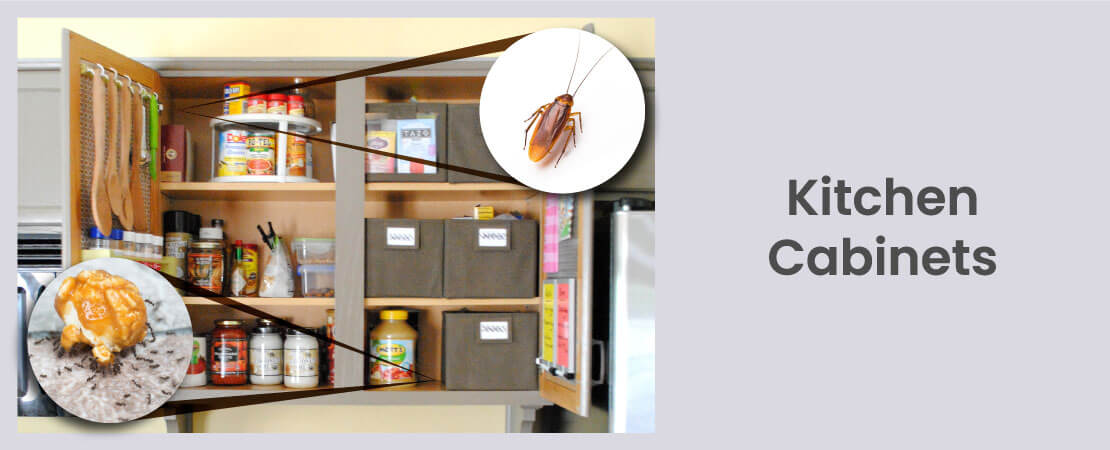
8. Kitchen Cabinets
It is not only the cabinet handles that you should worry about. The doors of the cabinet and the insides are equally important hygiene hotspots. Can you guarantee that you always wipe your washed utensils dry before keeping them inside the cabinets? You can’t. And the locked moisture inside gives rise to bacteria and other pathogens. Very often you might touch the cabinets and the insides even after handling raw food items direct from the market. That way, you give an entry pass to the germs.
Kitchen cabinets are also favourite hiding places of pests, especially roaches and ants. To eliminate them, you must get a pest control service1 done regularly.
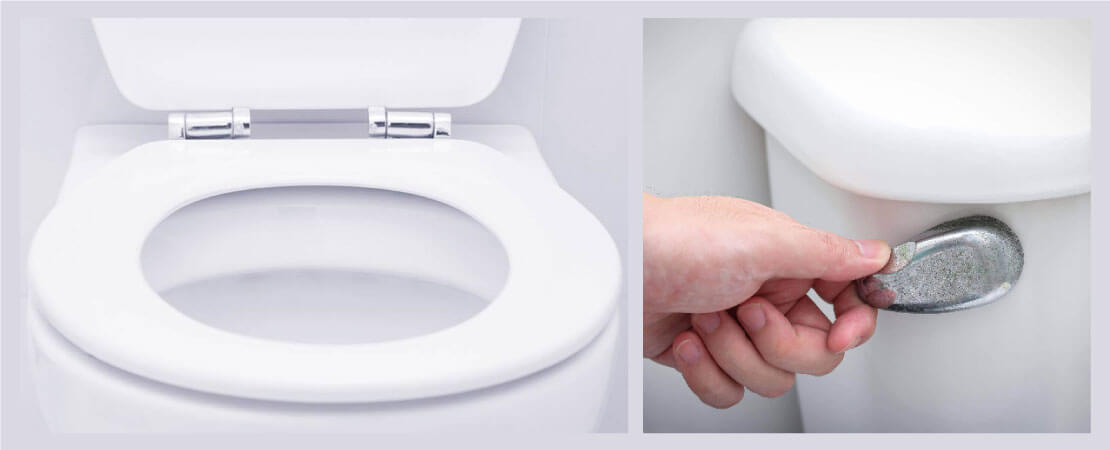
9. Toilet Seat, Cover& others
Yes, the seats and covers carry innumerable germs for obvious reasons! Touched by multiple users, incidents of backsplash, etc invite germs in and make these surfaces hygiene hotspots. Flush handle2 is also a germ spot which is a common touch point in your home.
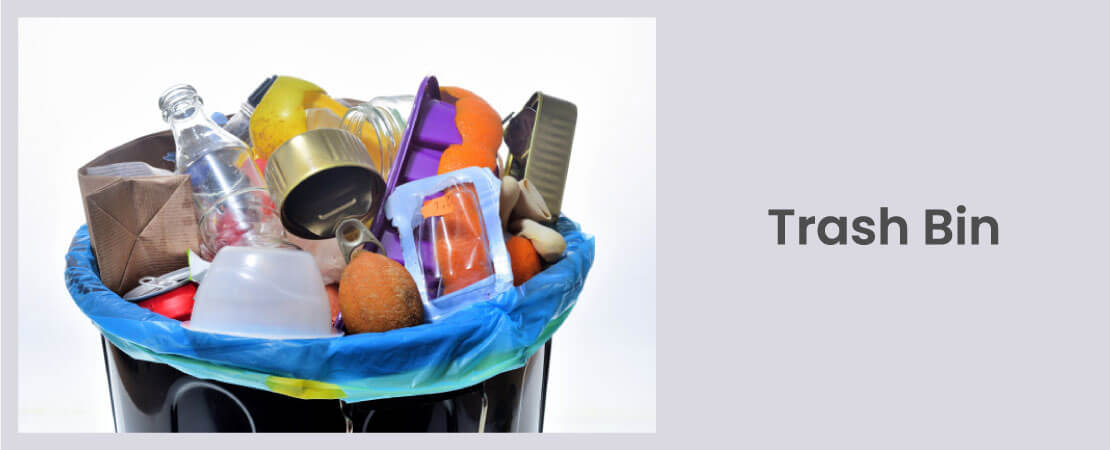
10. Trash bin
During the whole day, you touch the trash bin umpteen number of times and do not always wash your hand before moving on to other chores. Hygiene hotspot indeed!
Apart from this, damp corners of your home3 can also be a hygiene hotspot.
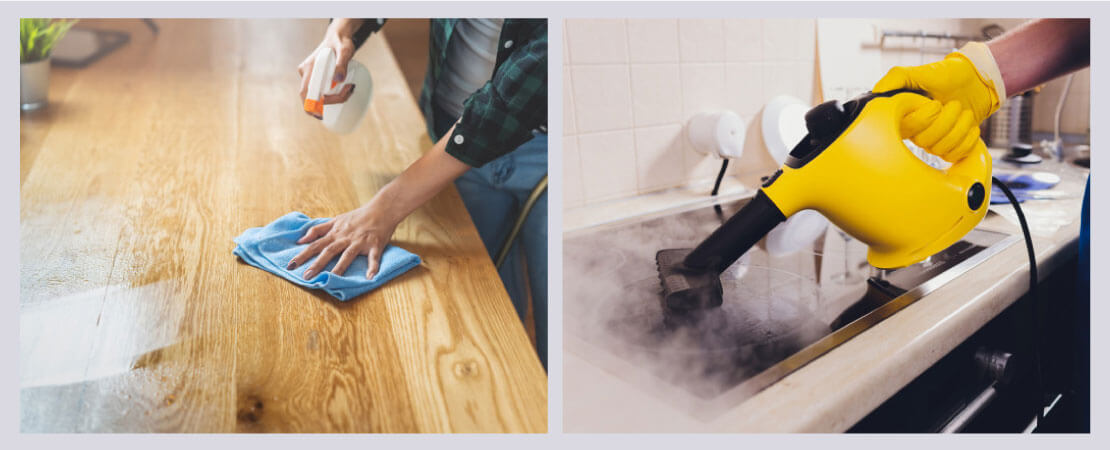
How to sanitize these hygiene hotspots?
Firstly, wash surfaces with soap and warm, clean water to remove dirt and debris. Next, sanitize surfaces with household bleach. To know more, click here4.
It is preferable that you should use different cutting boards for different items. Do not use the same cutting board for vegetables and non-veg items. Every time after use make sure you wash it with soap or detergent and water to get rid of the germs left behind.
Soak washcloth and sponges in lemon juice or white vinegar. Dry wet sponge thoroughly in the sun. Do not use the same cloth or sponge for more than a month.
Wash your hands well with soap after coming back home and then only handle the switches, doorknobs, kitchen utensils, TV remote, etc. For sanitizing these smaller surfaces you can always use all-purpose cleaner and wipe them with a microfiber cloth. Repeat this at least twice a week.
In this current situation, you can also opt for steam cleaning service5 which is safe and eco-friendly method of sanitization.
Additionally, close the toilet cover while flushing to prevent backsplash. Make sure you clean cover and the seat altogether before leaving the washroom.
After emptying your trash bin, wash the inside of it using soapy water and a brush.
If you choose to use any sanitizer or disinfectant, read safety rules6 & basics.
Lastly,don’t forget to wash and sanitize your hands.
To reduce the chances of contamination, you must wash and sanitize your hands7 frequently even while staying at home.
So this, in a nutshell, is how you take care of the hygiene hotspots scattered across your home. Sanitizing home8 is a difficult task. But it can never be ignored. With proper sanitization, you are 100% sure about putting a stop to the spread of germs.
Reference links used:
1. https://sanitizeyourplace.in/pest-control-disinfestation-services/
2. https://www.thesun.co.uk/living/3272186/this-is-how-many-germs-are-lurking-in-your-bathroom-and-youll-be-horrified-at-the-dirtiest-spot/
3. https://www.dettol.co.in/en/healthy-homes/home-hygiene-hotspots/
4. https://www.cdc.gov/healthywater/emergency/cleaning-sanitizing/household-cleaning-sanitizing.html
5. https://sanitizeyourplace.in/steam-cleaning-services/
6. https://sanitizeyourplace.in/basics-of-handling-cleaner-sanitizer-disinfectant/
7. https://sanitizeyourplace.in/importance-of-washing-and-sanitizing-your-hands/
8. https://sanitizeyourplace.in/
